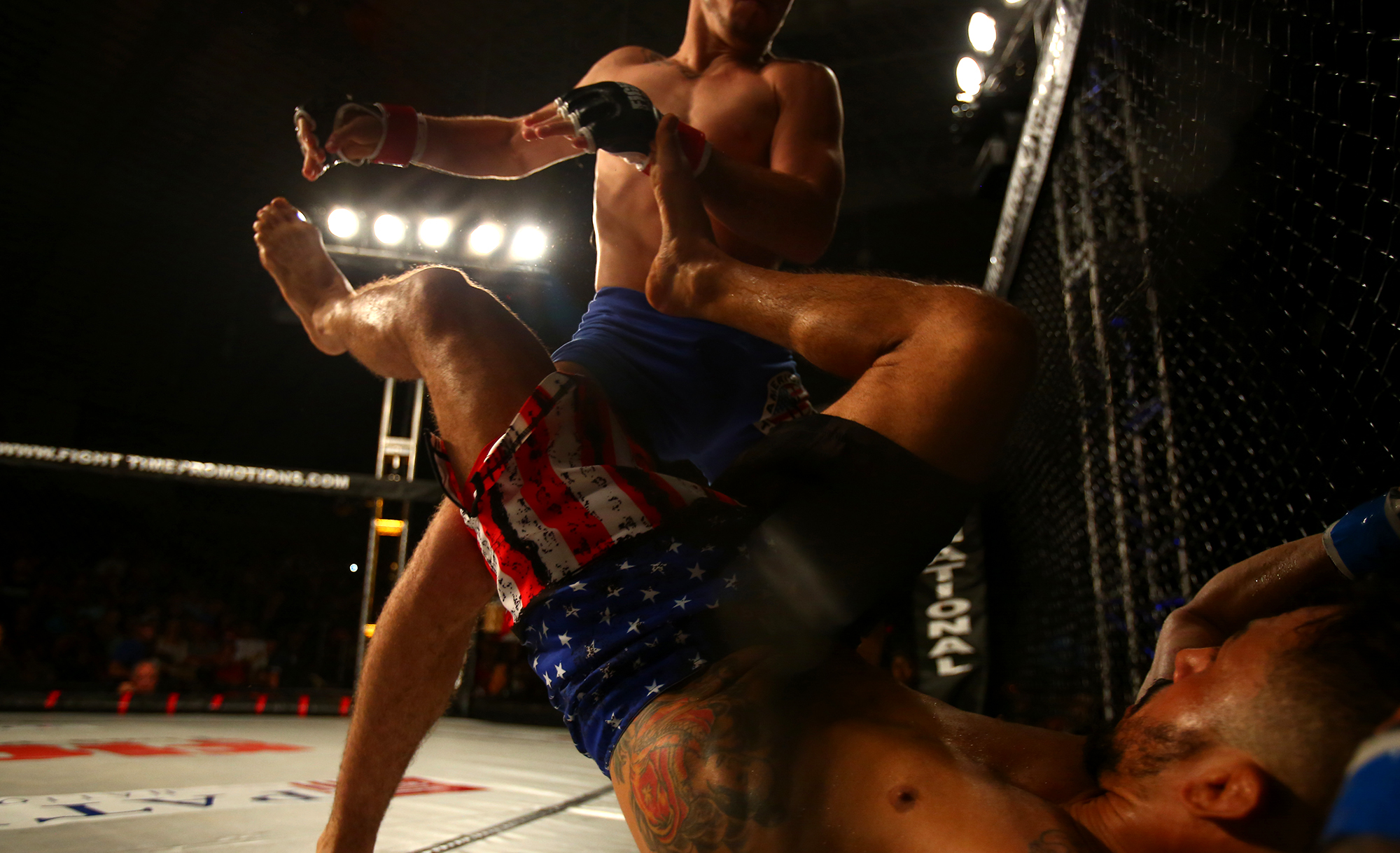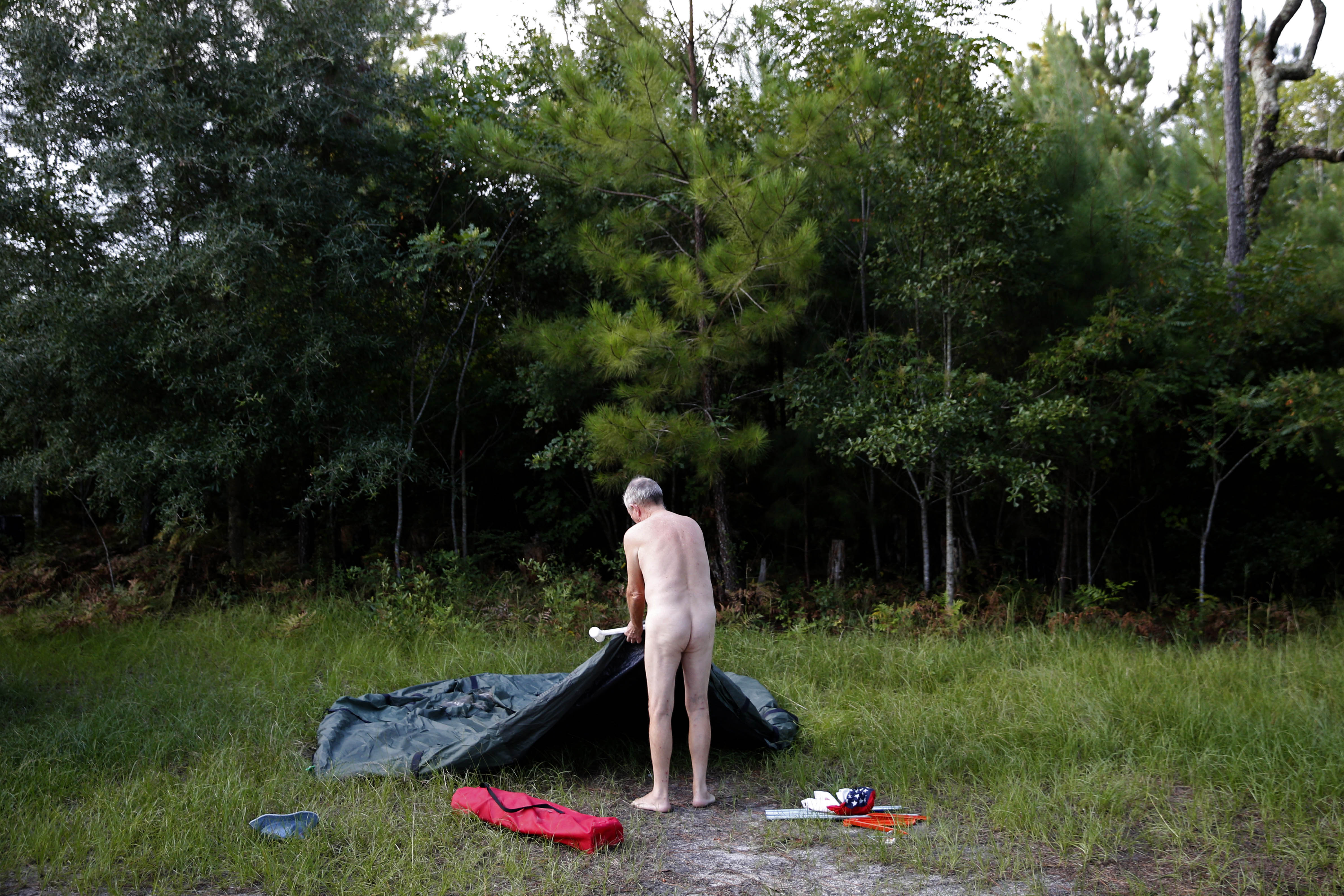
Steven Hiss sets up his tent for a night’s stay at Suntan Lake before a moonlight skinny dipping event between Tallahassee and FSU Naturally, two local nudist organizations on Friday, July 31, 2015. “Each person has different reasons. Body acceptance, whether their’s or somebody else’s, can be a lingering problem with some people,” said Hiss. “If you just forget about that, then you’ll feel fine.”
We are all naked.
Well, at least we all start out that way. Most of us spend our childhood fighting the best efforts of our parents to maintain that state. And in many cultures, people remain uncovered when living in climates where clothing is more of a hindrance than a luxury.
But somewhere along the way, that changes. Whether it is a question of societal norms, body insecurity or simple modesty; living sans clothing, for most, is not optional. But not everyone is living by those standards.
“I worked at the University of Florida (Horticulture Science Department) for 35 years and, in science, it’s either right, you haven’t found out, or it’s wrong — it’s just one of those three. I see nothing wrong with this at all,” said Steven Hiss, who sat fully nude, with the exception of his outdoorsman style bucket hat and a cold beer in hand.
Hiss is a longstanding member of Tallahassee Naturally, a group that rents a private lake near Monticello to spend their weekends with the freedom to shed their clothes and live what they call a naturist lifestyle.
The monikers of “nudist” and “naturist” seem vague in their discrepancy, though most at the camp agreed that one difference is that— though both sets enjoy being nude, nudists are those who want to gather in a club with like-minded individuals. Naturists enjoy being nude specifically amongst the wilderness, in a natural setting, either through the companionship of a group or all alone. Neither seems to be mutually exclusive.
“It is a natural part of being a human being,” said founder of Tallahassee Naturally Steve Haley. “If it’s freezing cold, I’ll pull on a sweater to get warm. But on an 80- or 90-degree day, I don’t want my body to be encumbered by clothes. I want to be naked. I want to be free. I want to be the way nature intended.”
History laid bare
Tallahassee Naturally has been around for decades, though it started under the name Tallahassee Bare Devils. Before formal organization, some of the original members were merely looking for a place to skinny dip as a weekend frolic where they utilized Sam Allen Lake, just south of Tallahassee. However, according to Haley, a police raid one afternoon in 1983 led to the arrest of seven skinny dippers. Six of them pled guilty and paid their fine.
However one of the skinny dippers, Anton Kronenburg, demanded a jury trial and obtained a lawyer to defend him. His charge: Florida statute 800.03: Exposure of sexual organs.
He was acquitted.
The raid was enough to make the group rethink their location scouting. In July 1990 they found a new, permanent location, a lake just south of Monticello. Because the lake was private, they were allowed to freely shed their clothes, without fear of reprisal from local law enforcement.
The new official locale helped the group grow in numbers, from 15 at the time to nearly 60 according to Paul LaValley, one of the founders of the club. Tallahassee Naturally is also boosted in numbers by Naturally FSU; the only officially recognized collegiate nudist organization functioning today.
On full moons during the summer months, the two groups combine for a moonlight skinny dip. During this July’s full moon, the groups were out to bare theirs.
“At first I was very shy about my body,” said Adrienne Yancey, a FSU computer science graduate student who stood proudly under the moonlight, with only the light of a tiki torch flickering over his naked body. “Eventually I just thought, why do I care what anybody thinks? Why cover up? Once I found that there was this group, I had to join. I feel at home.”
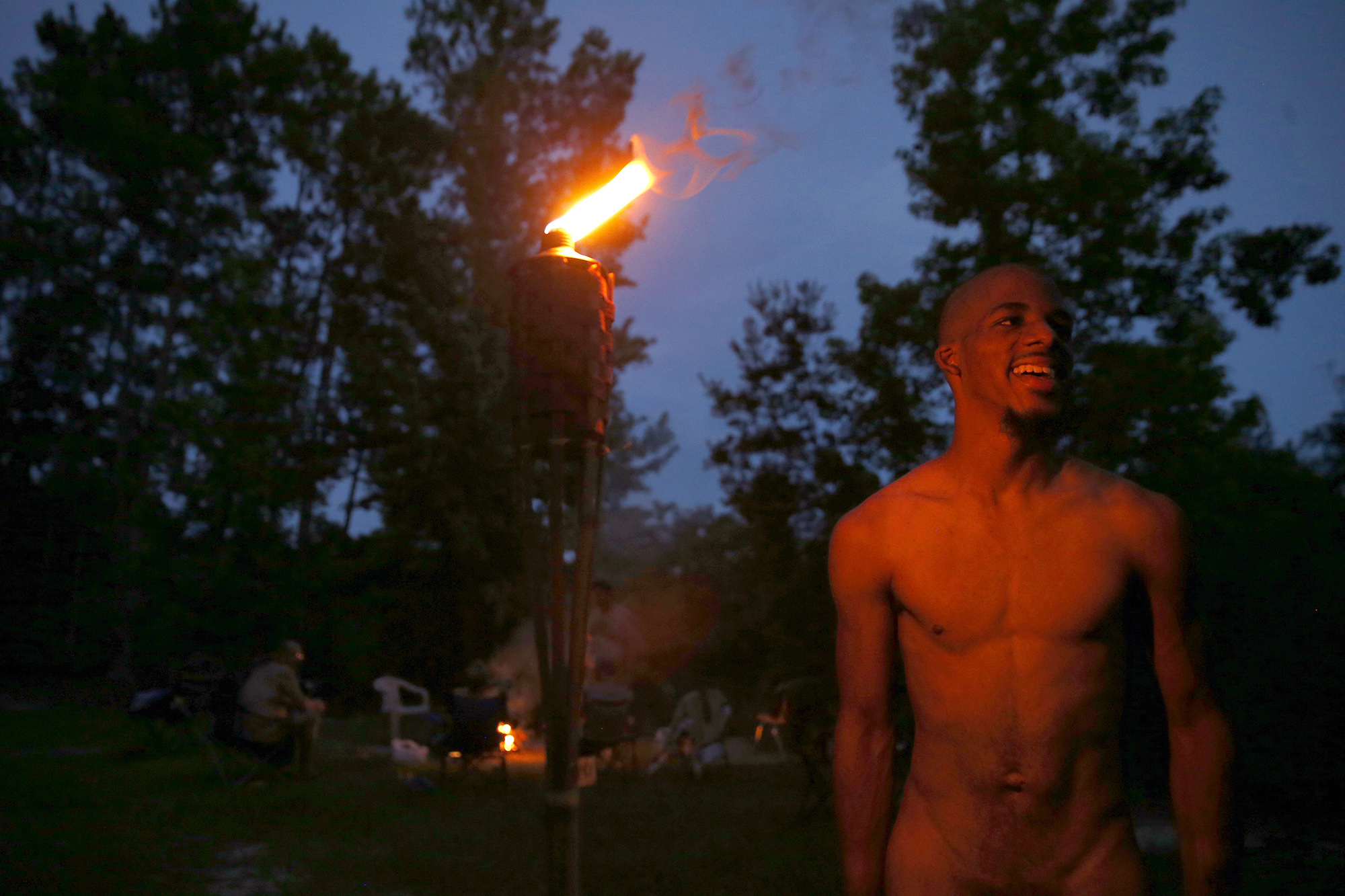
Adrienne Yancy, a FSU computer science graduate student, stands at the Tallahassee Naturally camp completely nude with a group that has gathered for a full moon skinny dip on Friday, July 31, 2015. “As soon I get home, I’ve just got to take [my clothes] off,” he said. “It feels natural because it is how the body was meant to be.”
Covered in nothing but bug spray
Clothes mask insecurities. They form a barrier, both in the way they cover and in a way that makes people feel as if they fit in. Wearing what others wear, doing what most do, is a way to make sure you are most accepted in society.
“Everybody has different taste. People wear long sleeves, people wear short sleeves, some people wear tank tops and the majority of them — they are self-conscious about themselves,” said Brandy Cain, manager of Classee With Attitude, a clothing shop just up the road in Monticello from the private lake naturists who are doing their best to shed themselves of the idea that clothing is necessary for comfort. Cain says her clothes and expertise in finding the right fit help to relieve some of those insecurities. “That’s what I’m here for,” she says, “to help them feel confident when they step out that door.”
Without the protection of clothing, and in the middle of the woods, bug spray becomes the covering of choice. The waves of people that show up throughout the night quickly ask around to find a lacquering of spray to hide their most vulnerable, and newly exposed areas from the swarm of yellow flies and mosquitoes that are thick in the brush.
Though even within this group — a gathering of people who have decided to shed the cultural norms in the name of personal freedom, to take a stand against the judgment they’ve found outside of the barrier of the private and gated lake, to adhere to their own idea of what feels right — there is a fear of simply sharing the idea that they are here.
As carloads of people come and go from the dimly lit patch of forest, one theme seems to run throughout: few people want to talk about their visit. Whether it is fear of judgmental neighbors, co-workers or fellow students, future job interviews or potential dates — people are mostly scared to share their stories.
Even in a group that might be perceived as free spirited, one where there isn’t a stitch of clothing in sight, a distinct idea of reprisal emerges — all for the simple act of taking a naked moonlight dip.
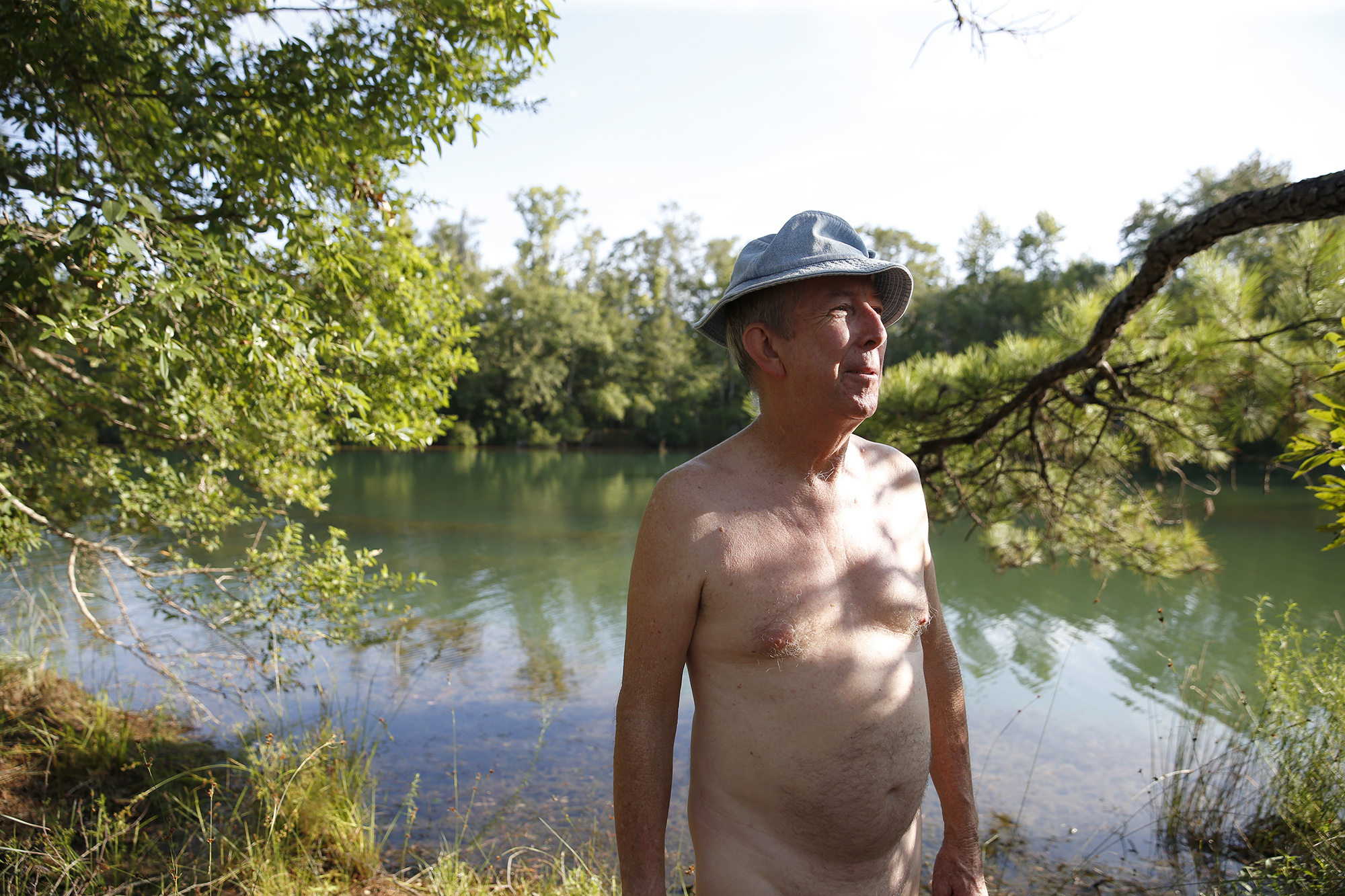
Steven Hiss stands along the shores of Suntan Lake before a moonlight skinny dipping event between Tallahassee and FSU Naturally, two local nudist organizations on Friday, July 31, 2015.
Though dozens of people show up to swim and mingle throughout the night — both young and old, men and women — most don’t want to talk. Some of the few that will, aren’t willing to share their names.
“We are by far the most prudish of all the western democracies,” said Haley, who is one of the alternate few: unabashed in his willingness to speak about his enjoyment in being nude. “There is something in the American psyche that finds the nude body to be sinful.”
And that is felt, even here in the dark. Even here on a private lake where the entire idea is to remove not only one’s clothes, but the preconceived notions that taking them off is wrong. Here where societal concerns have forced even the freest of us to forget — we are all naked.
Joe Rondone/Tallahassee Democrat
See the story published here
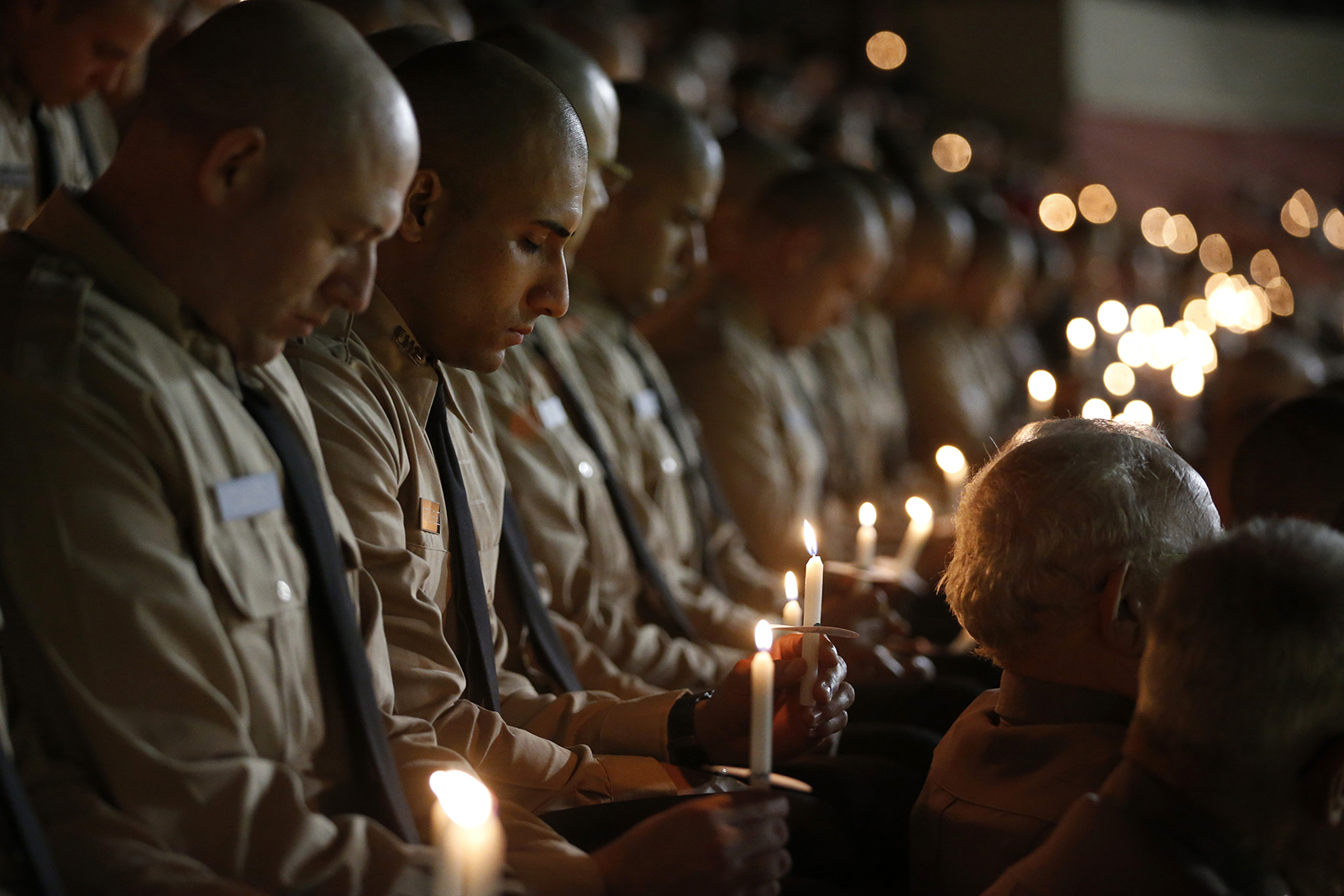
Community members and law enforcement officials gather together at Florida State University’s Dick Howser Stadium for a vigil to celebrate the life of Deputy Chris Smith, who was killed in the line of duty on over the weekend.
A city weary of recent gun violence mourned a hero Tuesday.
Leon County Sheriff’s Office Deputy Christopher L. Smith, 47, was laid to rest after a procession that saw thousands of people line the streets and law enforcement officers directing traffic pause to give a final salute.
A funeral service at the Bradfordville First Baptist Church on Thomasville Road was a standing-room-only affair, with a crowd that included Gov. Rick Scott overflowing the 1,300-seat venue. Law enforcement officers from across Florida came to show their support for a fallen comrade.
Smith was killed Saturday by a gunman who set a house ablaze in northwest Tallahassee to ambush first responders. The shooter was killed after a 12-minute gun battle. It was the second horrific event in three days, coming just after a gunman wounded three on the Florida State University campus.
Two speakers were on hand to lead the ceremony: the Rev. David Walker, pastor of the Calvary Baptist Church in Monticello, where Smith was a member, and the Rev. David Peacock, a pastor and former Jacksonville police captain.
Tears and brief moments of laughter punctuated the otherwise somber service as attendees mourned his loss, but also celebrated Smith’s life.
“He was just so fun to be around,” Walker said, while delivering his eulogy. “He was a person … I believe that he had a joking side that just in a minute, he could turn that thing and he could be serious. Boy, when he put that uniform on you know he could be serious.
“He loved what he did. Chris is in a place where there is no sorrow, there’s no pain, there’s no weeping … there’s no criminals. There’s no confrontation. There is absolute peace.”
Walker, who had presided over the marriage of Smith to his wife, Erika, spoke of being with Smith the Wednesday before his death. Smith was volunteering at the Calvary church.
“On that Wednesday night we were talking about some more remodeling at the church,” said Walker. “Some of the contractors were asking for some helping hands and he said: ‘Preacher, I’d be there but I’ve got to work Saturday.’ Little did we know that would be his last day of work.”
On that fateful day, Smith and Deputy Colin Wulfekuhl were the first on the scene of the fire.
“This individual, who I won’t even refer to as a man because he killed a man, murdered a man, he is less than a man who doesn’t deserve the title … because he hates the government … he decided to murder somebody who was actually defending his right to be opposed to the government,” said Peacock. “There is no greater honor than a man who will lay down his life for a friend, but Deputy Smith also died for his enemies.”
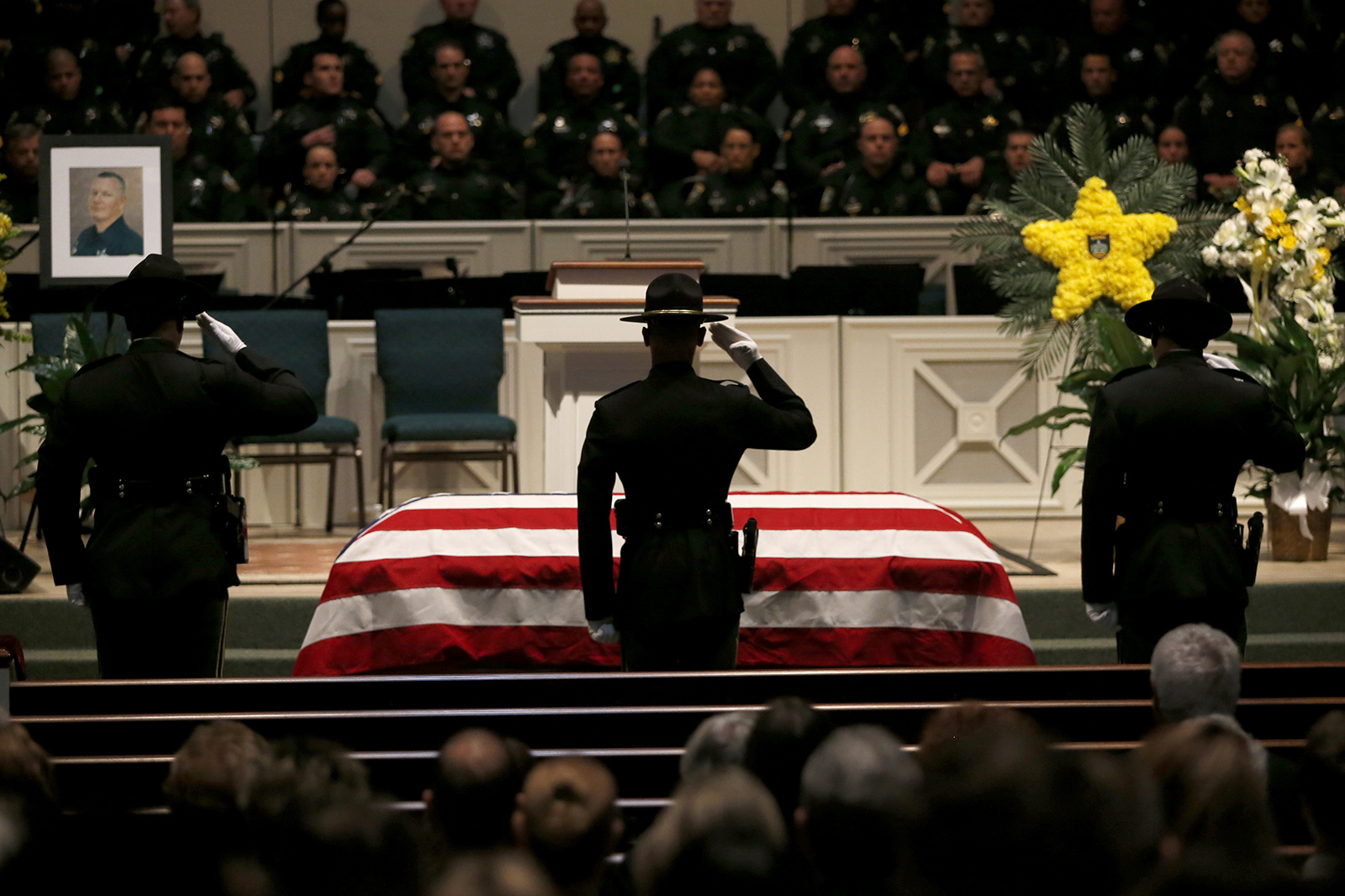
Law enforcement officials salute the casket of Deputy Christopher Smith of the Leon County Sheriff’s Office during his funeral procession at the Bradfordville First Baptist Church on Tuesday Nov. 25, 2014.
After the funeral, law enforcement officials streamed out to Thomasville Road where the funeral procession become a statewide parade, including hundreds of official vehicles, steered through the gray and rainy afternoon. The procession of cars took nearly an hour, passing bystanders who stood out in the rain along the road holding American flags and signs commemorating the fallen deputy.
One placard in the church lobby gave a list of “Promises Fulfilled,” a religious testament to the measure of a creator who holds a place where the pain set on earth is released for those who make it to an afterlife; a sentiment offered to ease the pain of grievers.
It was reminder of the fragility of humanity and that life holds no other promises.
Joe Rondone/Democrat
See the story on the Tallahassee Democrat here
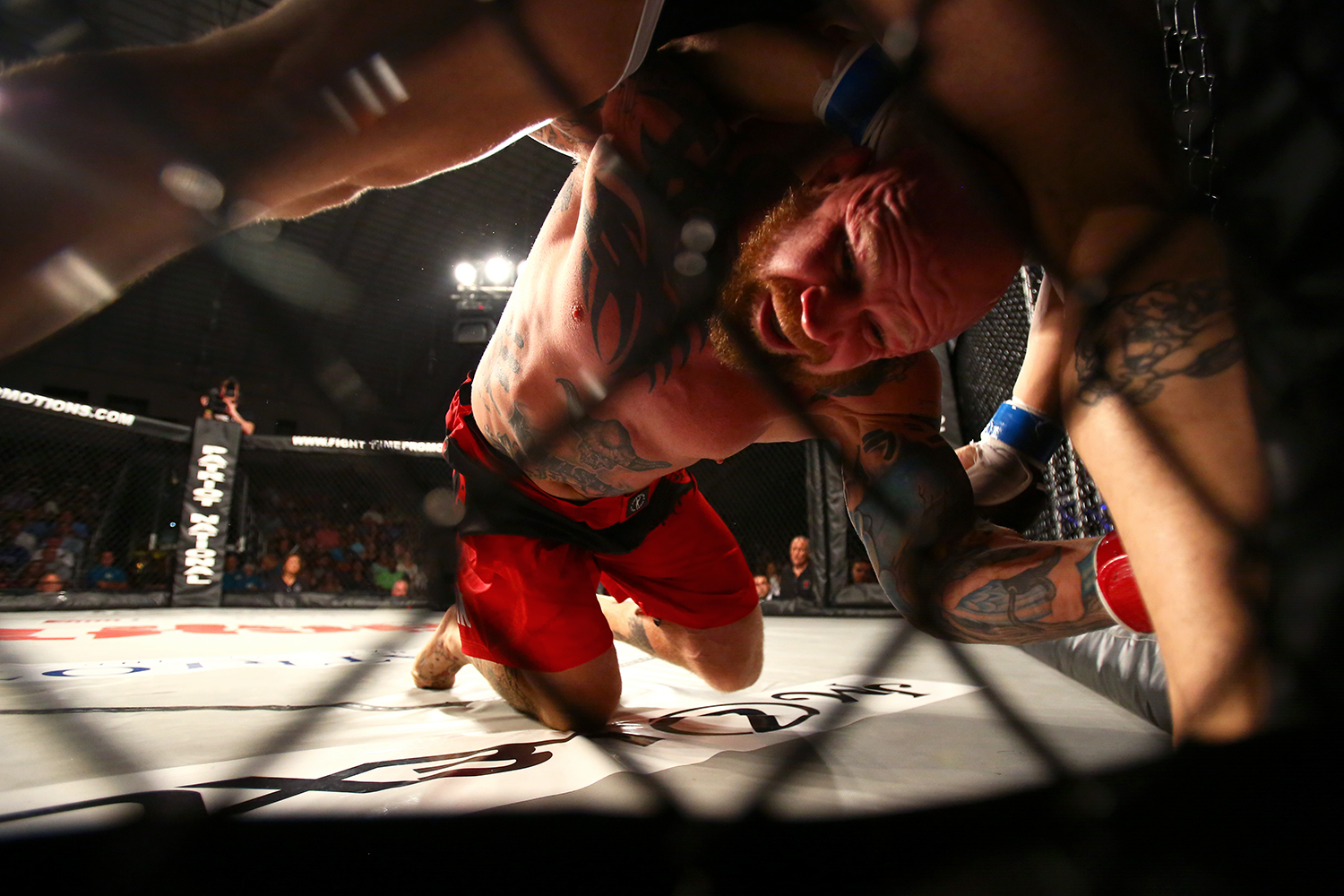
Jeff ‘The Snowman’ Monson reaches for the legs of his opponent, Kevin Brooks, at the Fight Time 20 Event at the War Memorial Auditorium in Fort Lauderdale. Monsoon went on to win the match with a choke hold in just over one minute, reaching the rare MMA milestone of 50 professional wins.
There is a brutal sound when a fighter’s fist strikes his opponent. The brief and immediate silence from the crowd that ensues feels nearly as deafening as the roar that follows. This is MMA.
Fort Lauderdale’s War Memorial Auditorium, aptly named for this mixed martial arts event, set the scene for Howard Davis Jr.’s Fight Time 20.
Among those competing was Jeff “The Snowman” Monson, who fought in the co-feature bout for his 50th victory. The 5-9, 240-pound Monson, who has fought professionally for nearly two decades, kept his focus away from the potential milestone win and on the giant brawler Kevin Brooks.
“I try not to pay attention to that. I’m trying to get back to what I do,” said Monson, 43. “I’ve got two more years of fighting, so I’m trying to get as much in as I can to be successful.”
The veteran of the sport has been a champion at the World Nogi Brazilian Jiu-Jitsu Championship and uses new practices to keep him competitive.
“Now I’m older. I still go as hard, I just can’t go as long,” he said. “You gotta pick up things. The sport’s evolving all the time — that or you become a dinosaur.”
His calm demeanor borne of experience is a stark contrast to Marcos and Mary Gomes, who are smoking cigarettes anxiously outside as they await the fight between Miguel Restrepo and their son, Marcos Jr.
Gomes is a flyweight just starting out in the professional ranks. He stands backstage at 2-0, with an amateur record of 6-0.
“I feel a little anxious, but we’re used to it,” said his mom, a 10-year resident of Deerfield Beach after relocating from Massachusetts with the family. “He’s been doing it his whole life, since he was 5. The nerve part of it is gone, but you still get anxious.”
His dad has seen him steadily improve since those childhood martial arts classes he took as a kid in the Northeast.
“He’s trained with the best,” he said of his son’s training at American Top Team in Coconut Creek. “He could take me ever since he was in high school when he was wrestling. We’re very proud of him; he trains very hard.”
Moments later, they enter the auditorium as their son is about to take the main stage. Gomes is stunned by a few punches and takes a devastating (but illegal) knee to the face, but he battles back to finish the fight and beat Restrepo on points to stay undefeated.
Monson is calm as he enters the ring. However, after going for a take-down, he’s caught by Brooks and driven face down into the mat, taking several blows to the back of the head. In a quick break from the onslaught, Monson escapes just long enough to put his massive arms around Brooks’ neck and force him into a north-south choke, which gets Brooks to submit and bring his record to 50-19-1.
The milestone win, accomplished in a little more than one minute, still took its toll on Monson: “He hits pretty hard, so I’m pretty sore.”
Joe Rondone/Sun-Sentinel
See the story on the Sun-Sentinel here
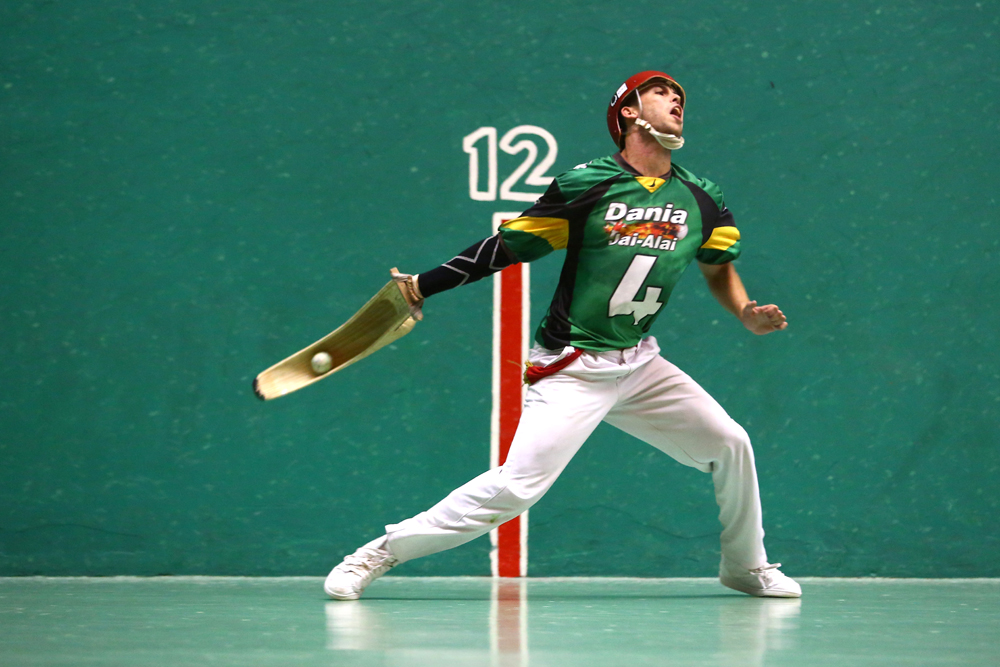
Daniel Spinner, a Boca Raton resident, is one of the few U.S. born players to compete professionally in the South Florida Jai-Alai circuit. He grew up watching some of the Spanish-Basque players that he currently competes against at Dania Jai-Alai, where the paramutial sport struggles to keep its doors open.
While gaming alternatives have proliferated in South Florida in recent years, a long-standing local tradition described as “ballet with bullets” works to stay relevant.
Crowds have dwindled over the years at Dania Jai-Alai, but there still remains a dedicated following among fans and players for a game filled with athleticism and beauty.
“I saw jai alai for the first time when I was 10 years old here at Dania. My parents took me here, and I loved it,” said Daniel Spinner, 23 and a Boca Raton resident. “It’s the fastest, most up-tempo ball sport in the world. I first started to play when I was 16 with a tennis ball on one of the walls in my neighborhood.”
Spinner is playing professionally at Dania Jai-Alai on his second six-week stint, battling for a shot at a permanent roster spot.
His journey is an increasingly unique one. At its peak, the sport was financially healthy, and owners were able to pay for amateur classes and programs that provided young talent an introduction to the sport. Today it’s harder to get involved as there are fewer places to learn the game. Cost also is a hindrance. The basket, or cesta, used to catch the ball can cost upward of $500 and is painstakingly crafted from reeds found in the Pyrenean Mountains in Spain. Pelotas can cost more than $100 and are hand-sewn.
And increased competition also has squeezed the local frontons.
“In the mid ’90s, the whole landscape of the sport changed as far as the gambling aspect. A lot of competition came in, which kind of obligated the [frontons] to be open more often,” said Benny Bueno, Dania Jai-Alai’s operations manager who also was one of the sport’s best local players for more than 20 years. “In other words, go to a year-round schedule in fear of closing down for three months and losing all your clientele to other attractions.”
That “clientele,” though fewer in numbers, are still passionate about the game. They enjoy seeing the pelota hurled in excess of 100 miles per hour and players flying around the court, climbing up walls and diving for the goat-skinned, rock-hard rubber ball.
Players display deft footwork and athleticism on the more-than-150-foot-long court. The rules are simple, much like racquetball and handball — players compete by trying to get the ball past one another after striking the main wall of the three-sided fronton. To this day, some of the best players in the world come to South Florida to play out their professional career.
The fast-paced action remains a draw for David Benjamin, 94, of Miramar. He started watching jai alai in the late ’50s and has been coming to the games in Miami and Dania ever since.
Benjamin is a diehard fan — in perhaps the most literal way possible.
“I went one afternoon and my heart started doing something; I was about to get a trifecta, and I was ready to get a heart attack,” he said. “It turned out to be a quadruple bypass, but I wouldn’t leave jai alai until the game was over.”
Despite the sport’s financial struggles, Bueno still sees hope.
“I think in this format, it’s limited,” he said. “There’s this feeling that, ‘If I don’t gamble, I can’t watch.’ I’ve always thought that this sport, the real chance that it has to make a huge comeback, is where you have rivalries where each city builds a strong team and there’s no gambling; it’s just to see who wins and loses.”
Joe Rondone/Sun-Sentinel
See the story with accompanying video on the Sun-Sentinel here
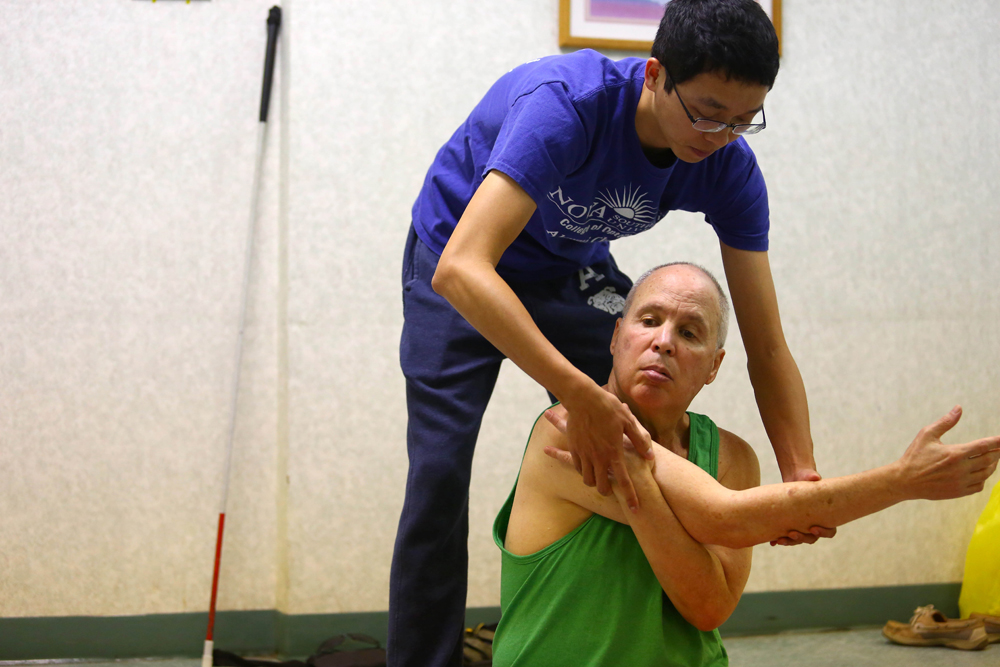
Volunteer Chaun Hu helps Sanford Rosenthal stretch during a faith yoga class at Lighthouse of Broward in Fort Lauderdale. Rosenthal is completely blind and recently went through triple-bypass heart surgery, he is using yoga to rebuild his strength while creating minimal strain on his heart.
Tapping a white cane along the narrow hallway walls, Sanford Rosenthal makes his way to a back room of the Lois L. Deicke Center and slowly feels the floor for the soft cushioning of his yoga mat.
“Can I have a second mat?” Rosenthal asks as he pushes down, feeling for the give of his padding. “I usually have two.”
Rosenthal is participating in the Lighthouse of Broward’s free weekly Faith Yoga class for the visually impaired. The program, sponsored by the One Yoga Foundation, is one of many offered by the Fort Lauderdale-based group aimed at providing solutions to help foster independence.
While most yoga classes involve imitating an instructor to learn the poses, in Faith Yoga, instructors spend time describing in detail each pose while volunteers help guide participants to the specific poses. The volunteers also act as spotters, as certain poses require more balance.
“I love yoga. This program was created specifically for people who are blind or visually impaired, so it’s very descriptive,” said Judy Wolgang, who has been taking the class since its inception in 2007. “If you can’t see the instructor, you’ve got to know what to do.”
Vicki Gaebe is one of the regular instructors. She enjoyed helping with the program so much that it helped her decide to become certified as a yoga instructor.
“Three years ago, I fell in love with this program and each and every one of [the participants],” she said. “I came up as an assistant, and a year ago I got my yoga teacher certification, and the inspiration for me getting that was all of these people.”
Andrew Meit, who has auditory and visual impairment, has taken yoga classes at the center for five years.
“Being a disabled person is stressful to begin with, so [it helps to have] some way to deal with that, in a positive way. Yoga is a good way of doing that,” he said. “This program has led directly to physical good health for me.”
Joe Rondone/Sun-Sentinel
See the story on the Sun-Sentinel here

